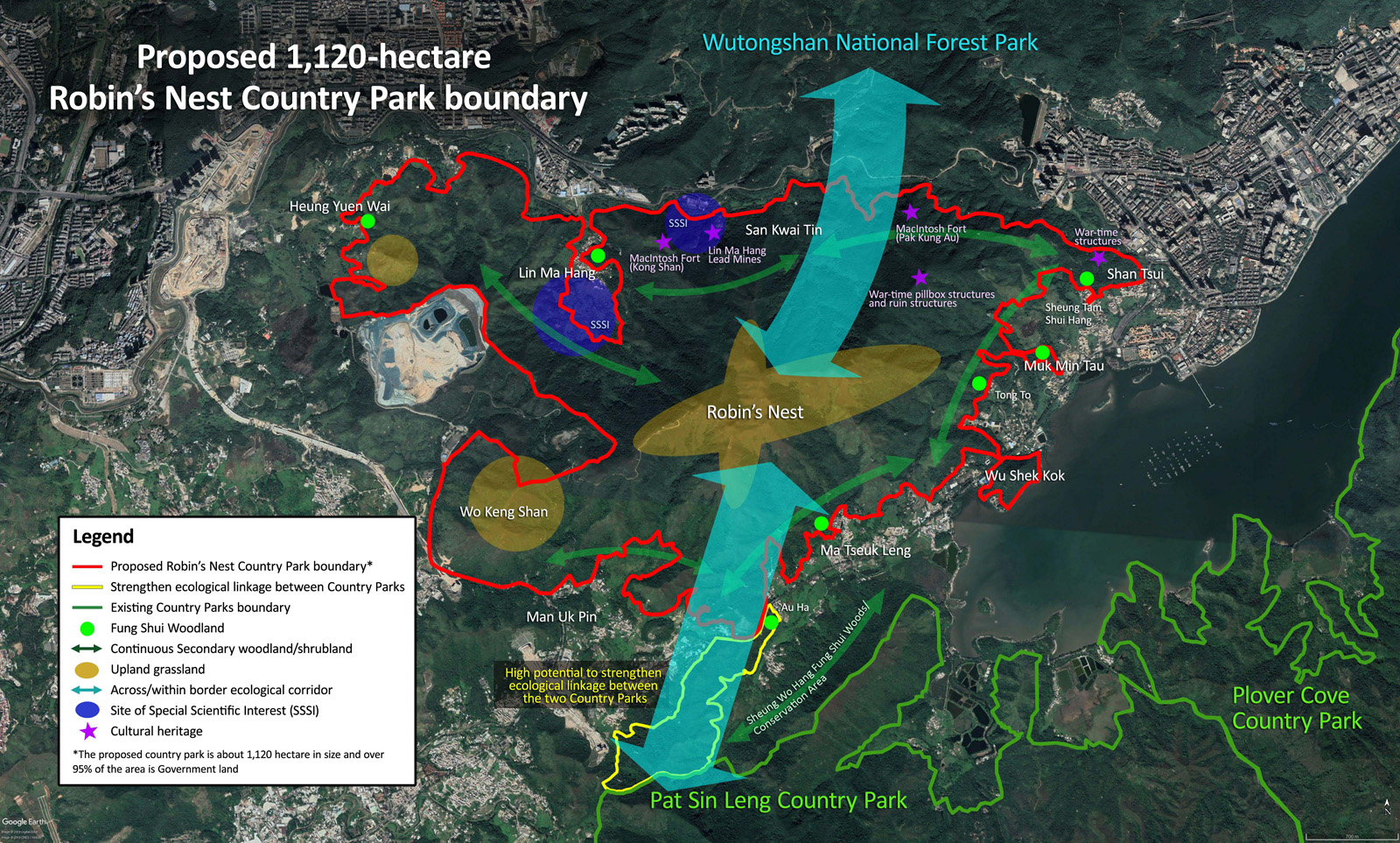
21 May 2019
The Government promised in the 2017 Policy Address that Robin’s Nest will be designated as a Country Park[1]. The Secretary of Environment Mr. Wong Kam Sing also confirmed in December 2018 that the designation of the Robin’s Nest Country Park (RNCP) is on its way and will be the 25th Country Park in Hong Kong[2]. We support this new Country Park as the conservation importance of Robin’s Nest has been repeatedly recognized since its identification as a potential Country Park some 26 years ago. We consider that the Country Park system is suitable for the protection, conservation and management of important ecological resources in the Robin’s Nest and associated areas (“Robin’s Nest area”). Below are the key justifications and principles that we expect the Government to follow in the upcoming RNCP designation process.
1. Robin’s Nest conservation value has for a long time been well-recognized by both the Government and groups
Back in 1993, the Territorial Development Strategy Review Study by the Planning Department already identified an area extending from Robin’s Nest to Wo Keng Shan as a potential Country Park. 10 years later, in 2003, Kadoorie Farm and Botanic Garden (KFBG) conducted a biodiversity study in the eastern Frontier Closed Area and recommended Lin Ma Hang, San Kwai Tin and Robin’s Nest to be included in a new Country Park[3]. The feasibility study of the Land Use Planning for the Frontier Closed Area (FCA Study) commissioned by the Planning Department in 2008 also recommended the designation of the RNCP[4]. Currently, “Designate new Country Park at Robin’s Nest, and extend Country Park to cover country park enclaves at appropriate locations” is Action2(b) under the Hong Kong Biodiversity Strategy and Action Plan (BSAP) (2016-2021) initiated by the Government. It is clear that the conservation of Robin’s Nest is well-recognized and the Government should therefore not further delay the designation.
2. The Robin’s Nest area is of high conservation significance
The northern slope of Robin’s Nest, extending from Shan Tsui to San Kwai Tin and Lin Ma Hang, is well covered with continuous secondary woodland intermingled with natural streams of conservation concern, it thus supports a high diversity of flora and fauna[3]. Two Sites of Special Scientific Interest (SSSIs) were even designated in this area for the conservation of the highly restricted, rare freshwater fish Chinese Rasbora and one of the most important bat colonies in Hong Kong[5]. Robin’s Nest is also important for the globally vulnerable Chinese Grassbird, for which Hong Kong is considered a stronghold. The Chinese Grassbird’s preferred upland grassland habitat stretches from the southern slope of Robin’s Nest to Wo Keng Shan and Heung Yuen Wai, while the lowland grasslands at Lin Ma Hang and Man Uk Pin are potential wintering sites of this species[6]. Many large fung shui woodlands with mature trees are found along the foot of the southern slope of Robin’s Nest[7].
3. The Robin’s Nest area is an important and unique ecological corridor
Robin’s Nest is well-recognized as the only obvious terrestrial ecological corridor between Hong Kong and mainland China[3],[4], with continuous secondary woodland at the northern slope ecologically connected to the Wutongshan National Forest Park in Shenzhen while strips of woodlands and other undisturbed vegetated areas at the southern slope are linked to those at the Pat Sin Leng Country Park. This corridor is the only well-vegetated pathway with little built-up area where wild animals (e.g. land birds, reptiles, amphibians, small mammals) can still move between Hong Kong and Shenzhen/Guangdong, thus their population in these two places can be healthily sustained. Therefore, all the habitats along this corridor should be well-protected to maintain such ecological connectivity both across and within the Hong Kong border. “Enhance habitat connectivity and establish ecological corridors across the boundary” is, in fact, required under Action 4(a) of the Hong Kong BSAP (2016-2021) which is a Government policy.
4. The Robin’s Nest area is of high cultural/historical and landscape significance
Various heritage resources within the Robin’s Nest area have different local historical interest or significance. For example, the Grade-2-listed Macintosh Forts at Pak Kung Au and Kong Shan served the role in bringing law and order to the frontier and in the control of illegal immigration[8],[9]. Some ruins, pillboxes and other structures are believed to have been built for defensive purpose during the 20th century[10],[11]. Lin Ma Hang Lead Mine and its adjacent ruins form good evidence in reflecting Hong Kong’s mining history[12]. The hilly terrain of Robin’s Nest is also identified as being of high landscape value in the Landscape Value Mapping of Hong Kong by the Planning Department in 2003[13].
5. Recreational potential of the Robin’s Nest Area
Since the opening-up of the Frontier Closed Area, Robin’s Nest is becoming more popular with hikers and groups, who wish to explore places like the Lead Mine, San Kwai Tin and Lin Ma Hang. Local people also regularly use the nature trails at Shan Tsui for passive recreational activities, while hikers utilise hiking trails from the southern side of Robin’s Nest (e.g. Ma Tseuk Leng) and Wo Keng Shan to access the summit. All these activities indicate the importance and urgency to designate the Robin’s Nest area to be a Country Park, in order to provide better protection (e.g. from undesirable human disturbance) and management (e.g. for the enjoyment of the public).
6. Expectations of better protection and management in Country Parks
The Country Park system, under the Country Park Ordinance (Cap. 208), offers a higher level of protection than the land use control under the Town Planning Ordinance (Cap. 131). Habitats of conservation concern can be actively managed and protected with regular patrols. Facilities for visitors and hiking routes can be designed, provided and maintained in the ecologically and scenically less-sensitive areas of the Country Park, for public education and enjoyment. Existing graves and burial grounds can be respected and managed within the Country Park for better regulation and fire prevention. Restriction of vehicle access to/in the Country Park is in place to prevent destruction of habitats and blockage of hiking trails caused by undesirable human activities or development. Given the high conservation, landscape and recreation value of the Robin’s Nest area, as explained in this and previous sections, we consider the aforementioned areas should be included into the proposed RNCP for better protection and management under the country park system.
7. RNCP boundary should follow the “Principles and Criteria for Designating Country Parks (2011)”
According to the 2011 Principles and Criteria[14], an AFCD policy document, conservation value, recreation potential as well as landscape and aesthetic value are the key themes of the intrinsic criteria for identifying suitable areas for designating Country Parks, while private land is not automatically taken as a determining factor for exclusion from the Country Park boundary. Therefore, the aforementioned areas of high ecological, historical, cultural and landscape value (please refer to sections 2, 3 and 4) should be included within the boundary of RNCP for nature and heritage conservation and management. Our proposed RNCP boundary, following the 2011 Principles and Criteria and respecting all the above RNCP justifications, is illustrated in the map attached.
Conclusion
It is clear that the justification for the designation of the RNCP is well-established and various groups support the designation of this new Country Park. We strongly urge the AFCD to consider our proposal and define the boundary of the RNCP according to the “Principles and Criteria for Designating Country Parks (2011)”. Our proposed RNCP is about 1,120 hectares in size and over 95% of the area is Government land. We consider that a well-justified boundary, set on the basis of conservation is important, as it empowers AFCD as the Country Park management authority for implementation, management and improvement of the proposed RNCP. We also note that establishing RNCP as an ecological corridor for terrestrial fauna will serve to connect Hong Kong’s Country Park network to protected areas in Guangdong, providing a good example of how Hong Kong’s experience in protected area management and conservation could contribute to the sustainable development of the Greater Bay Area. We sincerely hope all the above comments and recommendations can assist the Government to designate a Country Park that can truly contribute to the nature conservation in Hong Kong and China in general.

Six co-organized groups (in alphabetical order):
The Conservancy Association, Designing Hong Kong, Green Power, The Hong Kong Bird Watching Society, The Hong Kong Countryside Foundation, Kadoorie Farm and Botanic Garden
Supporting organizations (in alphabetical order):
Association for Geoconservation, Hong Kong, Ecology & Biodiversity Society, SS, HKUSU, Friends of the Earth (HK), Friends of Hoi Ha, Greeners Action, Greenpeace, Greensense, Hong Kong Outdoors, Living Islands Movement, Sai Kung Cattle’s Angel
[1] HKSAR Government. (2017, January 18). Paragraph 113 of 2017 Policy Address. Retrieved from https://www.policyaddress.gov.hk/jan2017/eng/p112.html
[2] Environment Bureau. (2018, December 13). 全新郊野公園?又點止咁簡單![A new country park? Not that simple!] Retrieved from https://www.enb.gov.hk/tc/sens-blog/blog20181213.html
[3] Kadoorie Farm and Botanic Garden. 2004. A Pilot Biodiversity Study of the eastern Frontier Closed Area and North East New Territories, Hong Kong, June-December 2003. Kadoorie Farm and Botanic Garden Publication Series No.1. Kadoorie Farm and Botanic Garden, Hong Kong Special Adminstrative Region. Retrieved from https://www.kfbg.org/upload/Documents/Free-Resources-Download/Report-and-Document/FCA-report-final.pdf
[4] Planning Department. (2010). Final Report of the Land Use Planning for the Closed Area. Retrieved from https://www.pland.gov.hk/pland_en/misc/FCA/frontier_eng/frontier_e1.htm
[5] Ades G.W.J. (1999). The species composition, distribution and population size of Hong Kong bats. Memoirs of the Hong Kong Natural History Society. No.22. PP 183-209
[6] Ho, W. G. [何維俊]. (2015). Status survey and conservation action plan for Chinese grassbird Graminicola striatus in Hong Kong, China. (Thesis). University of Hong Kong, Pokfulam, Hong Kong SAR. Retrieved from http://hdl.handle.net/10722/221835
[7] AFCD. (2006). Fung Shui Woods in Hong Kong (Advisory Council on the Environment Nature Conservation Subcommittee Paper NCSC 9/06). Retrieved from https://www.epd.gov.hk/epd/sites/default/files/epd/english/boards/advisory_council/files/ncsc-paper-06-09.pdf
[8] Antiquities Advisory Board. (2009). Historic Building Appraisal – MacIntosh Forts (Kong Shan). Retrieved from http://www.aab.gov.hk/historicbuilding/en/298_Appraisal_En.pdf
[9] Antiquities Advisory Board. (2009). Historic Building Appraisal – MacIntosh Forts (Pak Fu Shan). Retrieved from http://www.aab.gov.hk/historicbuilding/en/301_Appraisal_En.pdf
[10] 阮志(2016)。《越界﹕香港跨境村莊及文化遺產》。香港﹕三聯書店(香港)有限公司,187-188頁
[11] 劉蜀永、蘇萬興(2015)。《蓮麻坑村志》。香港﹕中華書局(香港)有限公司,175-177頁
[12] Trefor Williams. (1991). The Story of Lin Ma Hang Lead Mine, 1915-1962. Geotechnical Engineering Office, HKSAR (Ed.), Geological Society of Hong Kong Newsletter Vol 9 No.4, p.3-27. Retrieved from http://www.geolsoc.org.hk/_newsletters/Newsletter%201991%20Vol.9%20No.4.pdf
[13] Planning Department - Landscape Value Map of Hong Kong https://www.pland.gov.hk/pland_en/p_study/prog_s/landscape/e_executive_summary_hp/fig_31.htm
[14] AFCD. (2011). Review of the Criteria for Designating Country Parks and Proposed Measures for Protecting Country Park Enclaves (Country and Marine Parks Board Working Paper: WP/CMPB/6/2011). Retrieved from https://www.afcd.gov.hk/english/aboutus/abt_adv/files/common/WP_CMPB_6_2011eng.pdf



